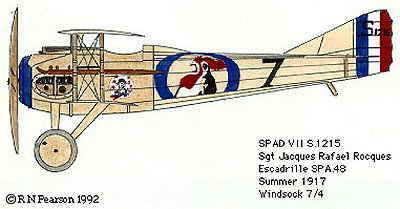The Societe Anonyme pour l'Aviation et ses Derives VII (SPAD VII):
Historical Notes:
However, the design was not without troubles, the primary being engine cooling. While operating in the field, many ground crews drilled holes into the cowling attempting to provide it with better ventilation. At the same time, the Spad company began to take steps to solve the problem by designing side engine panels with louvers, which became a trademark of Spad aircraft late in the war. Other problems included excess engine vibration which caused the engine bearers to fail, as well as the need to simplify the fuselage bracing system.
Another problem was the fact that the Spad VII was initially underpowered. The 150 hp "Hisso" was simply too weak for the heavy airframe, and maneuverability suffered drastically. But when married to the latest 180 hp Hispano-Suiza, the Spad VII came into its own. Climb rate improved considerably, as did the turn rate. Although still a little weak in the steady turn, the plane's snap turn was better than the Albatros machines it faced. However, this improved performance came with a price, as battlefield endurance was reduced from over 2 hours to 1 and a half hours. Nevertheless, the Spad VII proved itself a formidable combat opponent to German fighters, though still only armed with a single machine gun. Numerous squadrons of various nationalities flew the Spad VII, including units with Belgium, Czechoslovakia (postwar), Russia, Great Britain, the United States, and of course France. Over 3,500 of all types were built by France during the war, with some additional models built under license overseas. The type was made famous by such pilots as Renee Fonck and Georges Guynemer with the Storks Group (Groupes d' Combat 12; Fonck in SPA 103, and Guynemer in SPA 3).
Basic performance statistics: SPAD VII
Engine: 180hp Hispano-Suiza 8Ab
Weight: empty 1,100 lbs; loaded: 1,550 lbs
Maximum speed: 119.5 mph at 6,500 feet
Climb rate: to 6,500 feet.... 6 min, 40 sec.; to 9,800.... 11 min, 30 sec.
Service ceiling: 18,000 feet
Flight endurance: 1.5 to 2 hours (depending on source)
Basic Specifications (varied with model):
Manufacturer: Societe Anonyme pour l'Aviation et ses Derives (SPAD)
Dimensions: Span 25 ft 6 in; Length 20 ft, 1 in; Height: 7 ft, 8.5 in
Areas: Wings 192.1 sq ft
Fuel: na from sources
Armament: single Vickers machinegun mounted on cowling; 400-500 rounds per gun typical load.
Primary sources: "French Aircraft of the First World War," Davilla and Soltan; "Jane's Fighting Aircraft of World War I, 1919 (1990 reprint); "British Aeroplanes, 1914-1918," J.M. Bruce; "German Aircraft of the First World War," Gray and Thetford; "German Air Power in World War I," Morrow; "Aircraft vs Aircraft," Franks; "Who Downed the Aces in WWI?" Franks; "Aircraft Camouflage and Markings 1907-1954," Robertson et al; "Military Small Arms of the 20th Century," Hogg and Weeks.
Fighting and winning in the SPAD VII:
Nevertheless, it is important not to misuse the aircraft. It will not dogfight on equal terms with triplanes and other highly maneuverable aircraft. The best tactic to use on a triplane is the "dive and zoom" technique. Teamwork is also essential to survival and combat success. Two Spads working well together can best nearly any plane in the air, not just because of the odds, but because of good cooperation. And because it can take more damage, it is a good plane for setting up a more maneuverable enemy for the killing blow by a buddy.
The Spad VII is stable and easy to fly, although it can spin if mishandled. The best tactic is to typically climb as high above an enemy as possible and then to dive down upon him. Too much speed will cause the plane to vibrate violently, so immediately throttle back when in the initial dive. Once the firing pass is near completion, throttle up at once and pull away. Try to avoid the temptation to follow a more maneuverable machine into a turning fight. This is where you must know your WW I planes! However, standard German machines, like the Albatros and Pfalz, can be tangled with on even terms.
